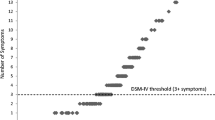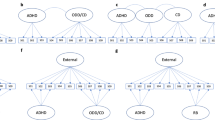Abstract
A dimensional approach was used to evaluate the internal validity of the DSM-III-R ADHD-inattention, ADHD-hyperactivity/impulsivity, oppositional defiant disorder (ODD), and conduct disorder (CD) symptoms (i.e., whether a symptom has a stronger correlation with its own dimension than the other three). Parents rated 4,019 children between the ages of 2 and 19 on these symptoms. The results showed that 5 of the 6 inattention symptoms, 3 of the 4 hyperactivity symptoms, 1 of the 4 impulsivity symptoms, 6 of the 9 oppositional defiant disorder symptoms, and 8 of the 11 CD symptoms had significant internal validity. Confirmatory factor analysis (CFA) found support for inattention, hyperactivity/impulsivity, oppositional defiant, and conduct disorder dimensions. Multiple-group CFA also found support for factor pattern and loading invariance across gender. The implications of these results as well as the merits of the dimensional approach to symptom validity are discussed in the context of the DSM-IV changes in ADHD, ODD, and CD.
Similar content being viewed by others
REFERENCES
Achenbach, T. M. (1995). Empirically based assessment and taxonomy: Applications to clinical research. Psychological Assessment, 7, 261–274.
American Psychiatric Association. 1987. Statical and diagnostic manual of mental disorders (3rd ed., rev.). Washington, DC: Author.
American Psychiatric Association. (1994). Diagnostic and statistical manual of mental disorders (4th ed.). Washington, DC: Author.
Barkley, R. A. (1996). Attention-deficit/hyperactivity disorder. In E.J. Mash & R. A. Barkley (Eds.),Child Psychopathology. New York: Guilford Press.
Bentler, P. M. (1995). EQS: Structural equations programs manual. Encino, CA: Multivariate Software.
Burns, G. L., & Patterson, D. R. (1990). Parent report of conduct problem behaviors in a stratified random sample of children and adolescents: New standardization data on the Eyberg Child Behavior Inventory. Psychological Assessment: A Journal of Consulting and Clinical Psychology, 2, 391–397.
Burns, G. L., Walsh, J. A., Owen, S. M., & Snell, J. (in press). Internal validity of the DSM-III-R and DSM-IV Disruptive Behavior Disorder Symptoms: Implications from teacher ratings for a dimensional approach to symptom validity. Journal of Clinical Child Psychology.
Byrne, B. M. (1994). Structural equation modeling with EQS and EQS/Windows: Basic concepts, applications, and programming. Thousand Oaks, CA: Sage.
Curran, P. J., West, S. G., & Finch, J. F. (1996). The robustness of test statistics to nonnormality and specification error in confirmatory factor analysis. Psychological Methods, 1, 16–29.
Fergusson, D. M., & Horwood, L. J. (1995). Predictive validity of categorically and dimensionally scored measures of disruptive childhood behaviors. Journal of the American Academy of Child and Adolescent Psychiatry, 34, 477–485.
Fergusson, D. M., Lynskey, M. T., & Horwood, J. (1996). Origins of comorbidity between conduct and affective disorders. Journal of the American Academy of Child and Adolescent Psychiatry, 35, 451–460.
Frick, P. J., Lahey, B. B., Applegate, B., Kerdyck, L., Ollendick, T., Hynd, G. W., Garfinkel, B., Greenhill, L., Biederman, J., Barkley, R. A., McBurnett, K., Newcom, J., & Waldman, I. (1994). DSM-IV field trials for the disruptive behavior disorders: Symptom utility estimates. Journal of the American Academy of Child and Adolescent Psychiatry, 33, 529–539.
Jöreskog, K., & Sörbom, D. (1993). LISREL 8: Structural equation modeling with the SIMPLIS command language. Hillsdale, NJ: Erlbaum.
Lahey, B. B., & Loeber, R. (1994). Framework for a developmental model of oppositional defiant disorder and conduct disorder. In D. K. Routh (Ed),Disruptive behavior disorders in childhood (pp. 139–180). New York: Plenum Press.
McDermott, P. A. (1996). A nationwide study of developmental and gender prevalence for psychopathology in childhood and adolescence. Journal of Abnormal Child Psychology, 24, 53–66.
Meng, X.-L., Rosenthal, R., & Rubin, D. B. (1992). Comparing correlated correlation coefficients. Psychological Bulletin, 111, 172–175.
Pelham, W. E., Gnagy, E. M., Greenslade, K. E., & Milich, R. (1992). Teacher ratings of DSM-III-R symptoms for the disruptive behavior disorders. Journal of the American Academy of Child and Adolescent Psychiatry, 31, 210–218.
Waldman, I. D., Lilienfeld, S. O., & Lahey, B. B. (1995). Toward construct validity in the childhood disruptive behavior disorders: Classification and diagnosis in DSM-IV and beyond. In T. H. Ollendick & R. J. Prinz (Eds.),Advances in clinical child psychology (Vol. 19, pp. 323–363). New York: Plenum Press.
Author information
Authors and Affiliations
Rights and permissions
About this article
Cite this article
Burns, G.L., Walsh, J.A., Patterson, D.R. et al. Internal Validity of the Disruptive Behavior Disorder Symptoms: Implications from Parent Ratings for a Dimensional Approach to Symptom Validity. J Abnorm Child Psychol 25, 307–319 (1997). https://doi.org/10.1023/A:1025764403506
Issue Date:
DOI: https://doi.org/10.1023/A:1025764403506




